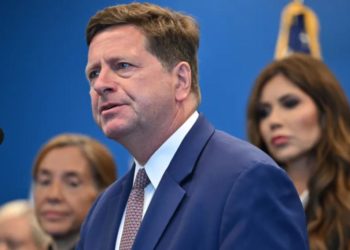The sudden stampede of European leaders to Washington on Monday to buttress Ukraine’s position in any future peace agreement with Russia seems to have paid off, at least in the short term, with the talks focused on security guarantees for Ukraine.
President Trump’s effusive welcome in Alaska last Friday for Russia’s president, Vladimir V. Putin, who had been in diplomatic isolation for more than three years after his full-scale invasion of Ukraine, prompted fears that Mr. Trump was about forge a peace agreement built around Russian demands.
Instead, the historic presence of President Volodymyr Zelensky of Ukraine and seven senior European leaders in the White House seems to have forestalled that outcome, not to mention a repeat of the disastrous meeting in February when Mr. Trump castigated Mr. Zelensky the Oval Office.
Starting with Mr. Zelensky, all the leaders present seem to have understood that flattering Mr. Trump was the surest way to avoid derailing talks. So in their opening remarks they underscored the fact that Mr. Trump had suggested that the United States would play an as yet unspecified role in security guarantees.
The discussions on Monday focused on that issue and little else, according to remarks by various leaders after discussions that lasted more than two hours.
“It is important for the United States to send signals that it will help,” Mr. Zelensky told reporters at a news conference at the White House. “This is a huge step forward,” he added. “The political will is there.”
It would take at least another 10 days to hammer out the details, he said, declining to be more specific, but the agreement thus far included a commitment from Ukraine to buy around $90 billion of American military equipment through its European allies, he said, including aviation and antimissile systems.
Ukraine had presented a list of weapons, he said, although it was unclear what the final outcome will be. “We have not found that everything will be granted, but it is just a start,” he said.
In addition, the United States will purchase Ukrainian drones when the country begins to export them. “This is going to be very important for us,” Mr. Zelensky said. “It’s going to help to finance our own production.”
During an interview on Fox News, Mark Rutte, the NATO secretary general, acknowledged that the Trump administration’s commitment to providing security guarantees for the Ukrainians remained vague. “What it will exactly mean — U.S. involvement — that will be discussed in the coming days,” Mr. Rutte said, although he described U.S. involvement as a “breakthrough.”
President Emmanuel Macron of France said that European leaders wanted to assert that Ukraine needed a strong army. “We’re going to need to help Ukraine with boots on the ground, to make sure that there is no intrusion from Russia in the future,” Mr. Macron said.
The Europeans had also been concerned about Mr. Trump’s assertion that a peace treaty could be negotiated without a cease-fire. They were still uneasy about that idea, Mr. Macron indicated.
“President Trump is convinced that he can come to a peace agreement without a cease-fire, and so we’ll see what happens, we’ll see how it unfolds,” Mr. Macron said. “But we all told him that we cannot discuss a peace agreement that takes several days, several weeks, as bombs continue to be dropped onto Ukraine.”
New direct and secondary sanctions remain on the table if Mr. Putin does not play ball, Mr. Macron said.
Mr. Trump had agreed that stopping the killing was a priority, he said. Security guarantees had taken up most of the discussion, he said, so the question of territorial swaps did not come up on Monday. The Europeans had been wary that Washington was going to hand the Kremlin pieces of Ukraine that it had been unable to win on the battlefield.
Mr. Trump and Mr. Zelensky did have a discussion about that topic in front of a large map of the battlefield that was on an easel in the Oval Office, the Ukrainian president said. And although Mr. Zelensky said he did not fully agree with what the map showed, he did not go into detail.
For his part, Mr. Trump said the next step should be direct talks between Mr. Putin and Mr. Zelensky, probably just the two leaders first and then with his participation. Mr. Zelensky said he was prepared for such talks in any format.
In Moscow, however, Yuri Ushakov, a policy aide to Mr. Putin, did not mention any such participation by the Russian leader in a summary he gave of a phone call that Mr. Trump made to Mr. Putin in the middle of Monday’s meetings.
The other European leaders at the meeting included Prime Minister Keir Starmer of Britain, Chancellor Friedrich Merz of Germany, Prime Minister Giorgia Meloni of Italy, President Alexander Stubb of Finland and Ursula von der Leyen, the president of the European Commission, the European Union’s executive arm.
During his brief remarks in Alaska last Friday, Mr. Putin said he hoped that the Europeans would not meddle in any agreements that he had reached with Mr. Trump, which he did not specify. But the Europeans appeared satisfied that they had achieved what they came for.
“Unacceptable decisions were not made,” Mr. Zelensky said. “I think that everyone of us has done the job.”
Zolan Kanno-Youngs contributed reporting.
Neil MacFarquhar has been a Times reporter since 1995, writing about a range of topics from war to politics to the arts, both internationally and in the United States.
The post A Rush to Washington Seems to Have Paid Off for European Leaders appeared first on New York Times.




